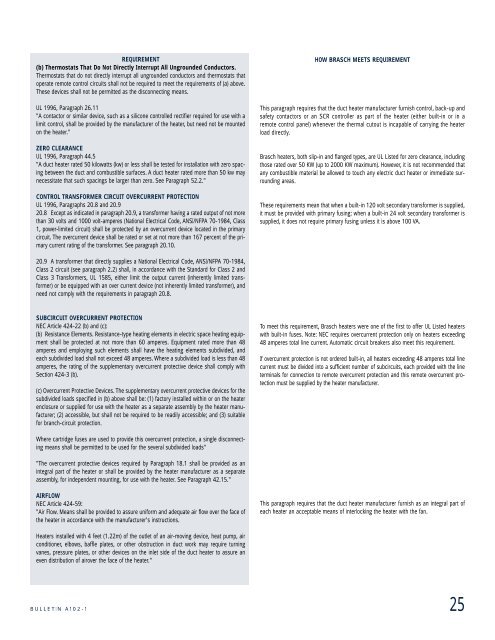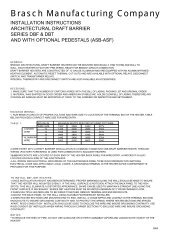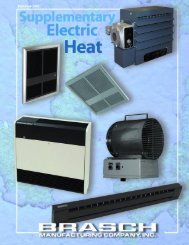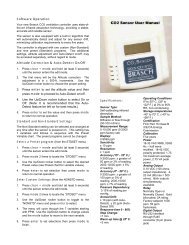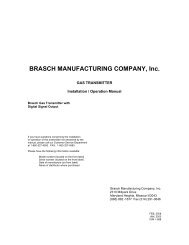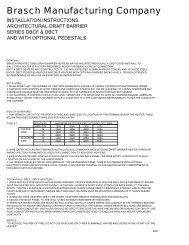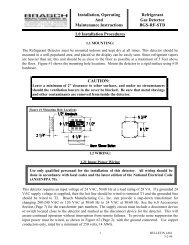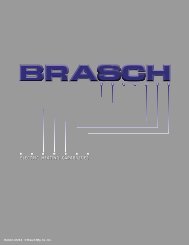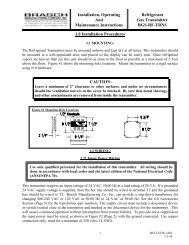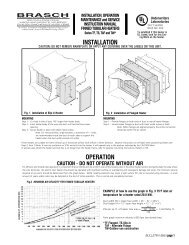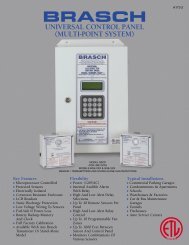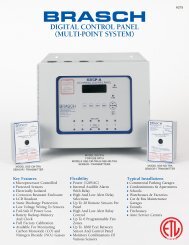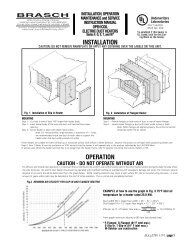A-102-1 Electric Duct Heater Brochure - Brasch
A-102-1 Electric Duct Heater Brochure - Brasch
A-102-1 Electric Duct Heater Brochure - Brasch
- No tags were found...
You also want an ePaper? Increase the reach of your titles
YUMPU automatically turns print PDFs into web optimized ePapers that Google loves.
REQUIREMENT(b) Thermostats That Do Not Directly Interrupt All Ungrounded Conductors.Thermostats that do not directly interrupt all ungrounded conductors and thermostats thatoperate remote control circuits shall not be required to meet the requirements of (a) above.These devices shall not be permitted as the disconnecting means.UL 1996, Paragraph 26.11"A contactor or similar device, such as a silicone controlled rectifier required for use with alimit control, shall be provided by the manufacturer of the heater, but need not be mountedon the heater."ZERO CLEARANCEUL 1996, Paragraph 44.5"A duct heater rated 50 kilowatts (kw) or less shall be tested for installation with zero spacingbetween the duct and combustible surfaces. A duct heater rated more than 50 kw maynecessitate that such spacings be larger than zero. See Paragraph 52.2."CONTROL TRANSFORMER CIRCUIT OVERCURRENT PROTECTIONUL 1996, Paragraphs 20.8 and 20.920.8 Except as indicated in paragraph 20.9, a transformer having a rated output of not morethan 30 volts and 1000 volt-amperes (National <strong>Electric</strong>al Code, ANSI/NFPA 70-1984, Class1, power-limited circuit) shall be protected by an overcurrent device located in the primarycircuit. The overcurrent device shall be rated or set at not more than 167 percent of the primarycurrent rating of the transformer. See paragraph 20.10.HOW BRASCH MEETS REQUIREMENTThis paragraph requires that the duct heater manufacturer furnish control, back-up andsafety contactors or an SCR controller as part of the heater (either built-in or in aremote control panel) whenever the thermal cutout is incapable of carrying the heaterload directly.<strong>Brasch</strong> heaters, both slip-in and flanged types, are UL Listed for zero clearance, includingthose rated over 50 KW (up to 2000 KW maximum). However, it is not recommended thatany combustible material be allowed to touch any electric duct heater or immediate surroundingareas.These requirements mean that when a built-in 120 volt secondary transformer is supplied,it must be provided with primary fusing: when a built-in 24 volt secondary transformer issupplied, it does not require primary fusing unless it is above 100 VA.20.9 A transformer that directly supplies a National <strong>Electric</strong>al Code, ANSI/NFPA 70-1984,Class 2 circuit (see paragraph 2.2) shall, in accordance with the Standard for Class 2 andClass 3 Transformers, UL 1585, either limit the output current (inherently limited transformer)or be equipped with an over current device (not inherently limited transformer), andneed not comply with the requirements in paragraph 20.8.SUBCIRCUIT OVERCURRENT PROTECTIONNEC Article 424-22 (b) and (c):(b) Resistance Elements. Resistance-type heating elements in electric space heating equipmentshall be protected at not more than 60 amperes. Equipment rated more than 48amperes and employing such elements shall have the heating elements subdivided, andeach subdivided load shall not exceed 48 amperes. Where a subdivided load is less than 48amperes, the rating of the supplementary overcurrent protective device shall comply withSection 424-3 (b).(c) Overcurrent Protective Devices. The supplementary overcurrent protective devices for thesubdivided loads specified in (b) above shall be: (1) factory installed within or on the heaterenclosure or supplied for use with the heater as a separate assembly by the heater manufacturer;(2) accessible, but shall not be required to be readily accessible; and (3) suitablefor branch-circuit protection.To meet this requirement, <strong>Brasch</strong> heaters were one of the first to offer UL Listed heaterswith built-in fuses. Note: NEC requires overcurrent protection only on heaters exceeding48 amperes total line current. Automatic circuit breakers also meet this requirement.If overcurrent protection is not ordered built-in, all heaters exceeding 48 amperes total linecurrent must be divided into a sufficient number of subcircuits, each provided with the lineterminals for connection to remote overcurrent protection and this remote overcurrent protectionmust be supplied by the heater manufacturer.Where cartridge fuses are used to provide this overcurrent protection, a single disconnectingmeans shall be permitted to be used for the several subdivided loads""The overcurrent protective devices required by Paragraph 18.1 shall be provided as anintegral part of the heater or shall be provided by the heater manufacturer as a separateassembly, for independent mounting, for use with the heater. See Paragraph 42.15."AIRFLOWNEC Article 424-59:"Air Flow. Means shall be provided to assure uniform and adequate air flow over the face ofthe heater in accordance with the manufacturer's instructions.This paragraph requires that the duct heater manufacturer furnish as an integral part ofeach heater an acceptable means of interlocking the heater with the fan.<strong>Heater</strong>s installed with 4 feet (1.22m) of the outlet of an air-moving device, heat pump, airconditioner, elbows, baffle plates, or other obstruction in duct work may require turningvanes, pressure plates, or other devices on the inlet side of the duct heater to assure aneven distribution of airover the face of the heater."BULLETIN A<strong>102</strong>-125


